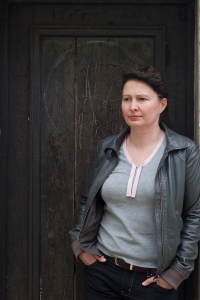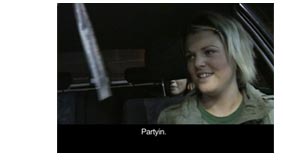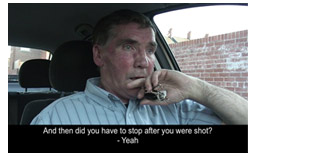Video artist Lisa Byrne gives an exclusive interview to Xavier Zapata about her recent work The Taxi Trilogy.
I was riding in a taxi in Wales, on my way to Bridgend in utter darkness. An urge to fill the gloom got me talking to the taxi driver. He spoke of how he’d just got back from fighting in Iraq. He said he had recurring nightmares of his friends dying and was afraid to sleep. Politics was living its virulent half-life in his dreams. And if politics is embedded in the unconscious then it’s everywhere. Lisa Byrne explores this phenomenon in her new work The Taxi Trilogy which was exhibited at Four Corners in Bethnal Green as part of the East London Film Festival. She grew up in County Down in Northern Ireland and lived through the height of the troubles. I met up with the artist to discuss how her work reflects the tumultuous politics of Northern Ireland.

Lisa Byrne (photo by Tim Bowditch)
To fund her art practice Lisa Byrne drove taxis in Northern Ireland. From these journeys she produced three short films consisting of conversations between her and her passengers. The first film Taxi 1: Partyin’ documents the night-time stories of people going out on the town. Her passengers are gripped by a joyful need to communicate. Like peacocks they perform, flashing their feathers inside the car. Lisa says that even here politics is simmering in the unconscious: “I wanted to show the escapism that people in Northern Ireland do. We’re all escaping the politics that has swept through our lives.” And this escapism gets extreme. The last passenger is a middle aged man who talks about his alcoholism: “I’ve been hospitalised twenty-one times. The last time the doctors gave me two weeks.” He slurs this phrase as his friend get in the taxi with a crate of beer.

Still from "Taxi 1: Partyin'"
Taxi 2: New Years Day 2007 5am is an uncomfortable film. Lisa told me the backstory. That night she’d picked up a dangerous man. He looked dodgy but she felt sorry for him, he was fifty miles from home on a freezing night wearing nothing but jeans and a t-shirt: “Not long before that I had seen someone dead on the road. I didn’t want the same thing happen to him.” He was friendly at first but became stony faced and difficult. Not long into the trip Lisa also picked up a couple and took them to Craigavon. The couple sat in the back with the other guy in front. Nobody said a word. The girl got off, but her boyfriend Adrian rode on a bit longer. When Adrian got to his stop he went to pay Lisa at her window. When he got to the window he signalled to her “Your man’s crazy. You’re gonna die. You should not take him anywhere.”
Adrian confirmed her fears and panic set in. Unsure what to do, she asked Adrian if he would join her on the long journey to drop off her dangerous passenger. Adrian agreed and popped into his house for five minutes. In that time Lisa got some chilling information about her passenger. She asked him why he had no cash for her. He replied it was because he sold drugs for the Ulster Freedom Force. The club he was in was controlled by a different paramilitary group, the Loyalist Volunteer Force, so he couldn’t sell his drugs there. Lisa says the terrifying paramilitary connection made her heart sink: “I’m a catholic. Adrian’s a Catholic. And we had a loyalist paramilitary in the front seat.” Adrian got back in the car and they started up their journey. But of course, Lisa was unable to tell Adrian the disturbing information about their fellow passenger. He was in the dark.
As the journey progressed the UFF man asked Lisa “What’s you name then love.” In Northern Ireland this means “What’s your religion.” Lisa refused to answer, Adrian stayed quiet. The journey continued in silence. When they reached their destination, the UFF guy went got into his house to get some money. In those moments Lisa recalls feeling petrified: “What if he pulls out a gun!” As he went to the window she got ready to put the car in reverse. Thankfully he produced only money, and Lisa returned the forty miles to drop Adrian off. She asked Adrian if she could film the return journey, which forms the basis of Taxi 2. She says the encounter was an important document: “I wanted to show where the political situation is right at this point. Terror activities have subsided, but the paramilitaries still exist as drug gangs.”
Taxi 2 records Lisa’s staggered attempts to tell Adrian the story behind their dangerous passenger. The audience only gets fragments of the story. Her own sense of panic hijacks the clarity of her testimony, and sudden cuts in the film extinguish the story’s development. Bits of the road were unlit, so parts of the film are totally dark. These elements keep the audience guessing. You don’t know why this passenger is so dangerous, so you fill the darkness with monsters. Then Lisa tells Adrian “He said he sold drugs for the UFF”. Suddenly an underworld of paramilitary activity is revealed. But it’s overheard; there is no image. All we see is dark space.

Still from "Taxi 2: New Years Day 5am"
Lisa says this un-answering darkness reflects the psychological impact of the troubles. “The unconscious of Northern Irish People is seeped in this history. The dark space is a metaphor for the unconscious. It holds the danger and complexity of Northern Irish people dealing with loss and death. It’s also the dark part of the road which wasn’t safe to drive through. Had I been there on my own with the paramilitary guy, it would have been the best place to kill me.” There’s an added potency here when you contemplate the lack of accountability during the troubles. Lisa says her neighbour’s two sons were shot in front of their eleven year old sister. No-one has been convicted. “Here’s a man who’s suffering terribly because of the loss of his children, there’s an empty space in his head. That empty space he’s going to continually circle and imagine things within it. That space needs to be filled in. He needs to know who was involved.” The dark spaces in Taxi 2 reflect these un-answering recesses of mind. It’s what Lisa calls “the social unconscious of Northern Ireland”. The genius of the dark spaces is that they force the viewers to unravel the story for themselves. You’re constrained to circle the void for answers. For a few moments you engage with the anxious landscape of Northern Ireland.
But something else is filling the empty space. Lisa is telling her story to Adrian, who in turn explains why he felt duty bound to protect her on her journey. Good storytelling elicits solidarity from your audience. The act of listening compels you to invest in the person telling you the story. In Taxi 2 Lisa Byrne creates an image for this phenomenon. This sensibility informs her aesthetic: “My work tries to invest something in another person.” She made the films by sticking a camera to the dashboard with a piece of blue-tack. With no-one behind the camera people can direct themselves. The camera itself is on automatic. It goes in and out of focus, directed by the movement of the journey. “Everyone is the author of themselves” she explains. The Taxi Trilogy is a world of storytellers, and it reflects a cultural legacy: “Northern Irish people are into telling stories. That’s their thing. Song became a big way of telling stories about the political situation in Northern Ireland.” These films are like songs and they reflect a need to talk about the political trauma. Lisa says “Creating an image in history of what’s happening is the starting point for healing.” When Lisa was a teenager her friend was shot by Loyalist paramilitaries. She says making The Taxi Trilogy has helped her cope with the loss. “Fifteen years ago people were numbing themselves to the troubles. Now they’re saying ‘Actually I’m having psychological problems, I need to deal with this.’ I think it’s time for artistic practice to allow these people to speak.”
In “Taxi 3: Stand up And Cry Like a Man” taxi-drivers tell Lisa their stories of surviving paramilitary attack in the eighties and nineties. Lisa explains how back then being a cabby was one of the most dangerous jobs around, “Everything was segregated, especially taxi firms. So they were easy targets because you knew they were either Catholic or Protestant. And these guys were always on their own.” On hearing the stories she found they all said the same things. They speak of their near death experience as an otherworldly “drifting” sensation. One man finds himself in “a bright white tunnel where I could see myself playing football as a kid”. When the trauma bites the effects are identical. These macho men are reduced to quivering insomniacs. One burly driver says, “My hair fell out within three days. It was coming out in handfuls.” The editing layers the stories together and if you closed your eyes you’d think you were listening to one man’s account. Lisa’s craft unites these men; they’re linked by a shared experience. It’s a powerful statement; these men come from Protestant and Catholic backgrounds.

Still from "Taxi 3: Stand up and Cry like a Man"
The film is over in three minutes. The audience has to keep up with this gasping pace which Lisa describes as like a machine gun. It resonates with what Lisa says about song and the troubles: “The rhythm of each song carries with it the rhythm of the turmoil.” The audience is at the mercy of choppy editing, bombarded by testimony and emotion. It’s a frantic overload which Lisa says is instilled in the Northern Irish public: “They will be a wee bit more jumpy, they’re traumatised by violence from the past.” In the same way you get swept into the mood of a song, these films immerse you in the emotional character of Northern Ireland. Lisa says the films were made for a mainland British public, to give us a fuller sense of what happened in Britain. Her work provides a powerful alternative to accounts portrayed in the mainstream media.
Xavier Zapata
